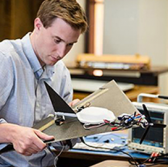 Johns Hopkins University Applied Physics Laboratory has developed a working prototype of an unmanned vehicle that can operate underwater and in the air.
Johns Hopkins University Applied Physics Laboratory has developed a working prototype of an unmanned vehicle that can operate underwater and in the air.
APL said Wednesday it plans to install sensor systems into the Flying Fish unmanned aerial-aquatic vehicle to support underwater data collection.
The Flying Fish UAAV is designed to fly at approximately 30 miles an hour, dive into land-locked body of water, collect data and perform reconnaissance, then fly out of the water to deliver data to operators.
The drone features a single propeller that works to deliver a continuous thrust force to the UAAV during water-to-air transition and adjust speed to suit water or air operations.
APL also envisions the use of Flying Fish to gather information in various areas of a large body of water, where it can fly between locations instead of moving underwater.




